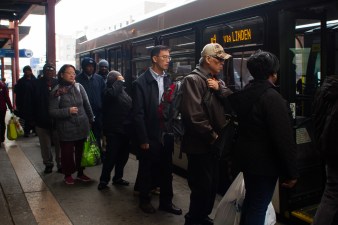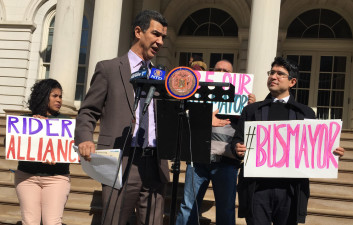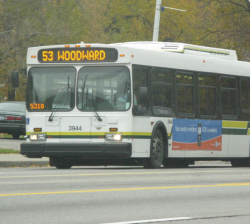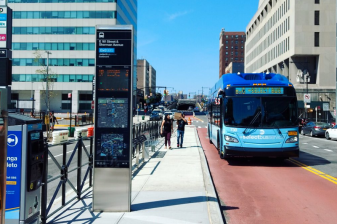No Wonder Bus Ridership is in Freefall — TransitCenter Grades 75% of Lines at ‘D’ or ‘F’
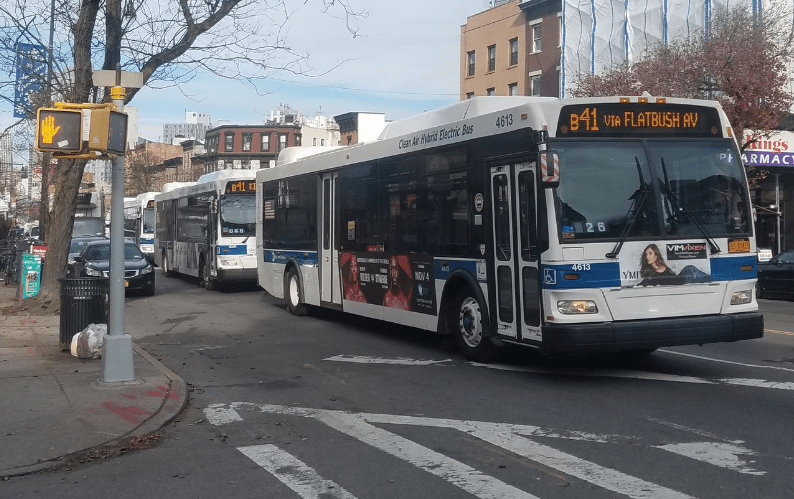
Almost three-quarters of New York City bus lines, and almost all of the routes in Manhattan, have earned a D or F grade from a leading transit advocacy group — pitiful performance that explains in part why bus ridership has dropped nearly 14 percent since 2013.
According to the Bus Turnaround Coalition report, fully 50 percent of city bus lines got a D grade, with 23.4 percent failing outright. The grades, based on a scale comprising on-time rates, bunching and overall speed, will be released at a press event on Wednesday.

Only one route in the city received an A: the Q52 Select Bus Service on Cross Bay and Woodhaven boulevards. As Streetsblog has reported, speeds are up 10 percent, and bus bunching is down dramatically, thanks to off-board fare payment and all-door boarding. As a result, ridership is improving.
“Slow, unpredictable service is costing New Yorkers time with their families, making them late for work and appointments, and exacerbating the city’s gridlock as more people turn to road-clogging ride-hail services like Uber and Lyft,” the group said in a statement.
Rounding out the grades are 57 C’s and 8 B’s. The report cards for every bus route are available at the website of the Bus Turnaround Coalition.
The report cards reflect what riders experience every day: average bus speeds were just 6.6 mph in 2018, down from 6.8 mph in 2017. And on routes with buses that are scheduled to arrive at least every 15 minutes, 1 in 9 buses arrived bunched, creating, as the group called it, “frustrating, unpredictable gaps in service.”
The grade breakdown by borough shows the depth of the problems in some areas. In Manhattan, 97 percent of bus lines were rated D or F. In Brooklyn and the Bronx, it was 87 percent and 79 percent, respectively. Staten Island had the best bus service, with 77 percent rated C or B.
Lines that improved — such as the B25 along Brooklyn’s Fulton Street, where the city created a dedicated bus lane, or the B82, which got select bus improvements — tended to stem from a concerted effort in a tiny area, rather than a more comprehensive fix, the Coalition said.

“Instead of rolling out changes on a handful of routes each year, City Hall and the MTA must make policy that’s commensurate to the problem and implement changes on a citywide scale,” the group advocated in a statement, which did give a hat tip to Mayor de Blasio’s recent proposal to improve bus speeds by creating more lanes and enforcing them better. The MTA has also said it will adopt all-door boarding as part of a fully redesigned bus network by 2021.
But it’s not enough, says the Bus Turnaround Coalition, which is calling for faster and more comprehensive implementation of the mayor’s bus lane plan, support from Council Members for new dedicated bus lane segments in their district, and more rapid rollout of known successes such as traffic signals that automatically give buses priority, all-door boarding, and redesigned bus routes.
“Council members need to step up and support DOT bus lane projects in their districts,” the group said in a statement. “Swapping out a few parking spaces could mean speeding bus trips for thousands of their constituents every day.”
Believe it or not, buses are getting better, with 30 fewer bus routes receiving failing grades this year (hold the applause: 31 more bus lines got Ds this year). But bus ridership is down from a recent peak in 2013 of 800 million yearly riders to 690 million last year — a decline of 13.75 percent.
Just for fun, here are the worst bus lines in each borough, thanks to receiving perfect F grades for speed and reliability:
- B12 (East NY to Prospect Lefferts Gardens in Brooklyn)
- M14D (14th Street in Manhattan)
- M20 (Lincoln Center to South Ferry in Manhattan)
- M55 (Bryant Park to South Ferry in Manhattan)
The Bus Turnaround Coalition includes TransitCenter, Tri-State Transportation Campaign, Straphangers Campaign and the Riders Alliance.
